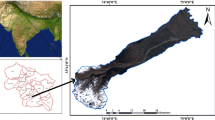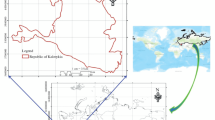Abstract
The increasing demand of water has brought tremendous pressure on groundwater resources in the regions were groundwater is prime source of water. The objective of this study was to explore groundwater potential zones in Maheshwaram watershed of Andhra Pradesh, India with semi-arid climatic condition and hard rock granitic terrain. GIS-based modelling was used to integrate remote sensing and geophysical data to delineate groundwater potential zones. In the present study, Indian Remote Sensing RESOURCESAT-1, Linear Imaging Self-Scanner (LISS-4) digital data, ASTER digital elevation model and vertical electrical sounding data along with other data sets were analysed to generate various thematic maps, viz., geomorphology, land use/land cover, geology, lineament density, soil, drainage density, slope, aquifer resistivity and aquifer thickness. Based on this integrated approach, the groundwater availability in the watershed was classified into four categories, viz. very good, good, moderate and poor. The results reveal that the modelling assessment method proposed in this study is an effective tool for deciphering groundwater potential zones for proper planning and management of groundwater resources in diverse hydrogeological terrains.













Similar content being viewed by others
References
Anbazhagan, S., Ramasamy, S. M., & Gupta, D. S. (2005). Remote sensing and GIS for artificial recharge study, runoff estimation and planning in Ayyar basin, Tamil Nadu, India. Environmental Geology, 48, 158–170.
Chenini, I., Benmammou, A., & Elmay, M. (2010). Groundwater recharge zone mapping using GIS-based multi-criteria analysis: a case study in central Tunisia (Maknassy Basin). International Journal of Water Resources Management, 24, 921–939.
Chowdhury, A., Jha, M. K., Chowdary, V. M., & Mal, B. C. (2009). Integrated remote sensing and GIS-based approach for assessing groundwater potential in West Medinipur district, West Bengal, India. International Journal of Remote Sensing, 30(1), 231–250.
Dar, I. A., Sankar, K., & Dar, M. A. (2011). Deciphering groundwater potential zones in hard rock terrain using geospatial technology. Environmental Monitoring Assessment, 173, 597–610. doi:10.1007/s10661-010-1407-6.
Dewandel, B., Lachassagne, P., Wyns, R., Maréchal, J. C., & Krishnamurthy, N. S. (2006). A generalized 3D geological and hydrogeological conceptual model of granite aquifers controlled by single or multiphase weathering. Journal of Hydrology, 330, 260–284.
Dhakate, R., & Singh, V. S. (2005). Estimation of hydraulic parameters from surface geophysical methods, kaliapani ultramafic complex, Orissa, India. Journal of Environmental Hydrology, 13, 1–11.
Gustavsson, M., Kolstrup, E., & Seijmonsbergen, A. C. (2006). A new symbol and GIS based detailed geomorphological mapping system: renewal of a scientific discipline for understanding landscape development. Geomorphology, 77, 90–111.
Jaiswal, R. K., Mukherjee, S., Krishnamurthy, J., & Saxena, R. (2003). Role of remote sensing and GIS techniques for generation of groundwater prospect zones towards rural development: an approach. International Journal of Remote Sensing, 24(5), 993–1008.
Jasrotia, A. S., Kumar, R., & Saraf, A. K. (2007). Delineation of groundwater recharge sites using integrated remote sensing and GIS in Jammu district, India. International Journal of Remote Sensing, 28(22), 5019–5036.
Jenson, J. R. (1996). Introductory digital image processing: a remote sensing perspective (p. 361). Upper Saddle River: Prentice Hall.
Kamal, A. S. M. M., & Midorikawa, S. (2004). GIS-based geomorphological mapping using remote sensing data and supplementary geoinformation: a case study of the Dhaka city area, Bangladesh. International Journal of Applied Earth Observation and Geoinformation, 6, 111–125.
Karanth, K. R. (1999). Groundwater assessment, development and management (p. 381). New Delhi: Tata McGraw Hill.
Kumar, P. K., Gopinath, G., & Seralathan, P. (2007). Application of remote sensing and GIS for the demarcation of groundwater potential zones of a river basin in Kerala, southwest coast of India. International Journal of Remote Sensing, 28(24), 5583–5601.
Kumar, M. G., Agarwal, A. K., & Bali, R. (2008). Delineation of potential sites for water harvesting structures using remote sensing and GIS. Journal of Indian Society of Remote Sensing, 36, 323–334.
Murthy, K. S. R. (2000). Groundwater potential in a semi-arid region of Andhra Pradesh: a geographical information system approach. International Journal of Remote Sensing, 21(9), 1867–1884.
Nag, S. K. (2005). Application of lineament density and hydrogeomorphology to delineate groundwater potential zones of Baghmundi block in Purulia district, West Bengal. Journal of Indian Society of Remote Sensing, 33(4), 522–529.
Rashid, M., Lone, M. A., & Romshoo, S. A. (2011). Geospatial tools for assessing land degradation in Budgam district, Kashmir Himalaya, India. Journal Earth System Science, 120(3), 423–433.
Rodell, M., Velicogna, I., & Famiglietti, J. S. (2009). Satellite-based estimates of groundwater depletion in India. Nature, 460, 999–1003.
Saraf, A., & Choudhury, P. R. (1998). Integrated remote sensing and GIS for groundwater exploration and identification of artificial recharge site. International Journal of Remote Sensing, 19(10), 1825–1841.
Sener, E., Davraz, A., & Ozcelik, M. (2005). An integration of GIS and remote sensing in groundwater investigations: a case study in Burdur, Turkey. Hydrogeology Journal, 13, 826–834.
Shahid, S., & Nath, S. K. (2002). GIS integration of remote sensing and electrical sounding data for hydrogeological exploration. Journal of Spatial Hydrology, 2(1), 1–12.
Singh, A. K., Parkash, B., & Choudhury, P. R. (2007). Integrated use of SRM, Landsat ETM + data and 3D perspective views to identify the tectonic geomorphology of Dehradun valley, India. International Journal of Remote Sensing, 28(11), 2430–2414.
Solomon, S., & Quiel, F. (2006). Groundwater study using remote sensing and geographic information systems (GIS) in the central highlands of Eritrea. Hydrogeology Journal, 14(10), 29–1041.
Sreedevi, P. D., Subrahmanya, K., & Ahmed, S. (2005). Integrated approach for delineating potential zones to explore for groundwater in the Pageru River basin, Cuddapah District, Andhra Pradesh, India. Hydrogeology Journal, 13, 534–543.
Srivastava, P. K., & Bhattacharya, A. K. (2006). Groundwater assessment through an integrated approach using remote sensing, using remote sensing, GIS and resistivity techniques: a case study from a hard rock terrain. International Journal of Remote Sensing, 27(20), 4599–4620.
Acknowledgements
The authors are thankful to the Director, National Geophysical Research Institute, Hyderabad, India for granting permission to publish the paper. The authors wish to acknowledge the Associate Editor and anonymous reviewers for their valuable comments and suggestions.
Author information
Authors and Affiliations
Corresponding author
Rights and permissions
About this article
Cite this article
Rashid, M., Lone, M.A. & Ahmed, S. Integrating geospatial and ground geophysical information as guidelines for groundwater potential zones in hard rock terrains of south India. Environ Monit Assess 184, 4829–4839 (2012). https://doi.org/10.1007/s10661-011-2305-2
Received:
Accepted:
Published:
Issue Date:
DOI: https://doi.org/10.1007/s10661-011-2305-2




